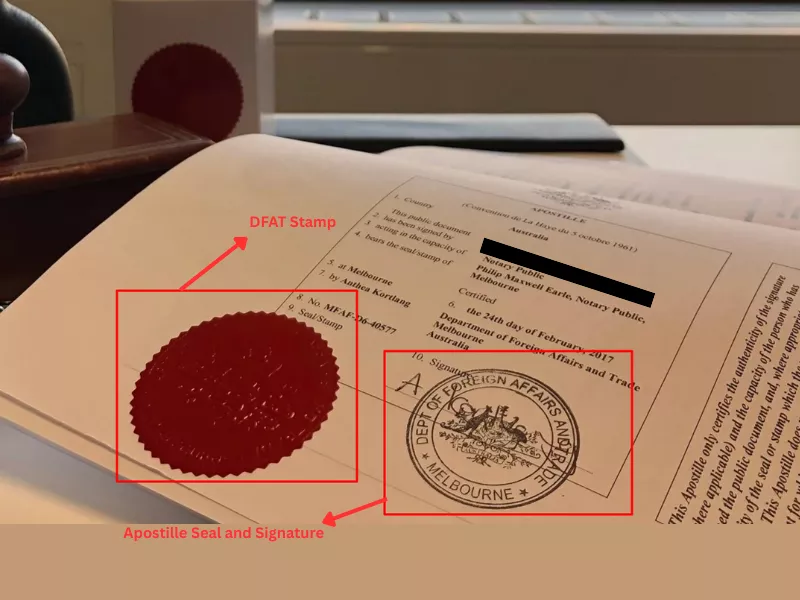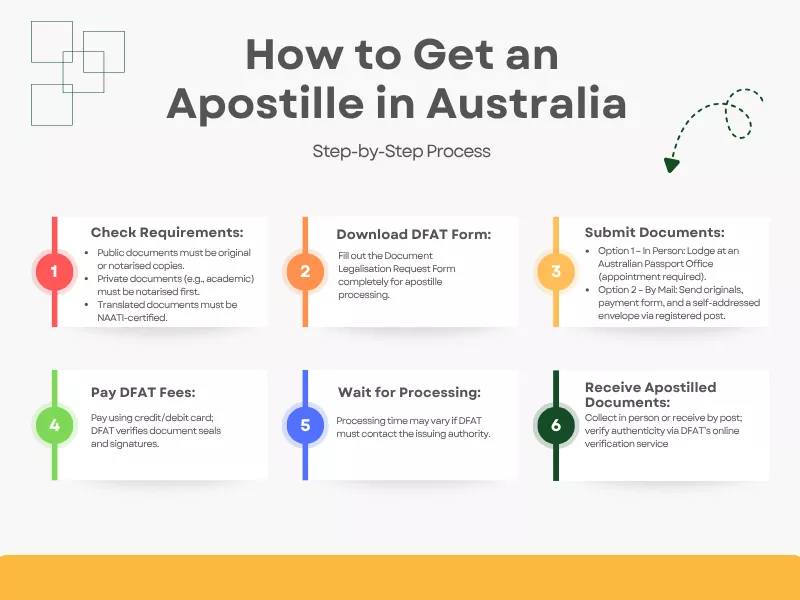If you want to use your original documents issued by the Australian government overseas, you first need to obtain an apostille service. This is a mandatory requirement set by destination countries, especially if they are signatories to the Hague Apostille Convention. This is required for legal, immigration, education, or employment purposes. If you are wondering, “How do I get an Apostille in Australia?”, this article will guide you through the process. We have discussed everything regarding the apostille process in Australia, along with up-to-date DFAT requirements, so that you get all the information in one place and get the job done without an info gap. Let’s start!
What Is an Apostille in Australia? Everything You Need to You!
An Apostille is the process of authenticating documents issued by authorities within Australia. It confirms and verifies the seal, stamp, and signature present in the original documents to enforce the legalisation for international use.
Who Can Apostille a Document in Australia?
The leading provider of apostille service in Australia is the Department of Foreign Affairs and Trade (DFAT). DFAT issues apostilles through the passport office in each Australia state and capital city.
How Does a DFAT Apostille Look Like and What Does it Include?
A document apostilled by DFAT comes with a separate certificate (the Apostille itself). This separate certificate is a 9×9 cm square standardised certificate with details including:
| Verification Details of The Original Document | 1. The name of the country where the document was issued originally 2. Issuance date of the original document 3. Name of the issuing Authority 4. Verification of the issuing authorities' seal or stamp 5. Verification of the authority of the person who issued the document with the name 6. Confirming the signature of the authoritative person |
| Authentication Details by DFAT | 1. Date of the apostille by DFAT 2. The apostille number (a unique number for tracking the certificate) 3. The official seal and stamp of DFAT 4. The name and signature of the DFAT officer who affixed the Apostille 5. In some cases, modern apostilles often include a QR code for instant, digital verification. |
*Please note that an apostille does not verify the accuracy of the document’s content, but only its official authentication.
For example, an apostilled document looks like the following:

What Documents Can Be Apostilled by DFAT?
DFAT can apostille a variety of documents, including:
Documents Issued by Various Australian Government Departments
These are public documents issued by Australian authorities, such as registries, courts, police, or other government departments. These include:
1. Australian Birth certificates (including commemorative certificates and extracts)
2. Marriage certificates (not ceremonial or commemorative ones)
3. Death certificates
4. Single Status or Record of No Result certificates
5. Court documents, including Divorce Certificates
6. National Police Checks or Fingerprint Reports
7. Australian citizenship certificates or International Movement Records (from the Department of Home Affairs)
8. Australian government commercial documents (for example, ASIC records, Certificates of Residency from the ATO, or TGA papers)
Educational Documents from Recognised Australian Institutions
This includes academic papers issued by recognised educational institutions in Australia. These include Australian private schools, colleges, registered training organisations (RTOs), TAFE institutions (Technical and Further Education), and the Australian Skills Quality Authority (ASQA). Examples include:
1. Academic degrees & diplomas
2. Awards
3. Transcripts
4. Certificates
5. Letters and other official university documents
These documents must be original, verified, and signed by an authorised officer from the state or territory’s education department.
Other Documents
Apart from private, public, and academic documents, the following documents are also eligible for apostille and authentication services in Australia. These include:
1. Private documents (such as Powers of Attorney, wills, bank statements, or company records)
2. Documents from an authorised Australian Chamber of Commerce and Industry
3. Documents in another language, if prepared by an Australian Notary Public
4. Certificates of incorporation for Australian companies
5. Notarised copies of passports, driver’s licences, or other ID documents
6. Documents translated by NAATI translators
7. Consent letters for children travelling overseas
Note: To get all these documents stamped with an apostille, you must use the original one. In case you are using an official copy of the original certificates or documents, those must first be notarised by an Australian notary public before DFAT authentication.
Should You Get Translated Documents Apostilled?

Yes! If the receiving country is a signatory to the apostille convention and its official language is not English, you must first get a translation of the Australian documents into that particular foreign language and then send them to DFAT for an apostille.
The major requirement for the translation before DFAT can apostille the document is that it must be certified. Self-translated copies are not eligible to get an apostille stamp.
Therefore, you need to hire NAATI Certified Translators to get certified translations, which must include:
1. Assigned certification statement to confirm it is the complete and accurate representation of the original document, including any stamps or seals on the original.
2. The translator’s full name, their signature, and their NAATI-registered number
3. The date of translation took place
4. The official NAATI stamp or seal on every page
Should I Get My NAATI Translated Documents Notarised by a Notary Public Before DFAT to Issue The Apostille?
No, you don’t need to notarise NAATI-translated documents before sending them to DFAT for an apostille. DFAT accepts translations done by NAATI translators if they include the required details mentioned above (such as the stamp or signature).
If you need NAATI certified Document Translation in Australia, AustralianTranslationService can help you out!
How to Get an Apostille in Australia?

Here’s a step-by-step process to lodge your document with DFAT to get an Apostille in Australia:
Step 1: Meet the Basic Requirements
1. For Public Documents issued by the Australian Government Offices: The documents must be original and undamaged. If using a certified copy, these must be notarised first by a notary public in Australia.
2. For Private Documents by Institutions in Australia: For private documents like academic documents, an apostille can not be done for the document without it being first notarised.
3. For Translated Documents: If using a translated document for apostille authentication, it must be NAATI-certified.
Step 2: Download the Form for DFAT to Issue an Apostille
After gathering the document and all required information, you can request notarial services by mail or in person. To do this, you must fill out the document legalisation request form. Print your document for completion. Make sure all sections are complete and accurate, as DFAT Apostille services will not accept incomplete forms.
Step 3: Submit the Form and Documents
There are two options when submitting documents for an apostille in Australia.
Option 1: Submit in Person
You can lodge your documents and forms at any Australian Passport Office. But you must book an appointment first. If you can’t attend, someone else can go for you. You can book your DFAT apostille appointment online for the office in your state or territory:
- Adelaide: australianpassportofficeadelaide.setmore.com
- Brisbane: australianpassportofficebrisbane.setmore.com
- Canberra: australianpassportofficecanberra.setmore.com/bookappointment
- Darwin: australianpassportofficedarwin.setmore.com
- Hobart: australianpassportofficehobart.setmore.com
- Melbourne: australianpassportofficemelbourne.setmore.com
- Perth: australianpassportofficeperth.setmore.com
- Sydney: australianpassportofficesydney.setmore.com
Note: Make sure you’ve prepared all required documents. Bring a credit or debit card for payment. Bring a self-addressed registered post envelope if you want your legalised documents returned by mail. Double-check that you meet all requirements. If your submission is incomplete, DFAT will reject it, and you’ll need to book another appointment to continue.
Option 2: Submit by Mail
If you can’t visit a passport office to apostille a document in Australia, you can post your forms and original documents via registered mail. When applying by mail, include:
- Your credit card authorisation (found in section 7 of the document legalisation request form).
- A self-addressed registered post envelope for the safe return of your documents.
Keep copies of both tracking numbers for your records. Send your application to one of the following addresses:
Australian Passport Office Authentications Section
GPO Box 2239
MELBOURNE VIC 3001
Australian Passport Office Authentications Section
GPO Box 2239
SYDNEY NSW 2001
Pay DFAT Apostille Fees & Wait for Processing
You must pay the DFAT apostille fee to complete your application. After you apply, DFAT officers will verify the signature or seal on your documents against their records. Once confirmed, they’ll issue an apostille certificate directly on your document. If DFAT needs to contact the issuing authority, the DFAT processing time may take longer. You’ll be notified if this happens.
Note: If your application is incomplete, DFAT will return your documents by post with a letter explaining the next steps.
Receive Your Apostilled Documents
If your application meets all requirements, DFAT will issue you an apostille document. You can collect the documents from the Australian Passport Office or receive them by post in the self-addressed envelope you included.
For more information, contact DFAT by email at legialisations.australia@dfat.gov.au.
Note: Once you receive your apostille, you can verify it online through the official DFAT verification service.
E-Apostilles for Electronic Australian Public Documents
DFAT accepts a limited range of official Australian public documents in electronic form. You must provide the original electronic version for DFAT to issue an apostille. When you submit the document by mail or in person, DFAT will first assess it. Officers need to review the document before confirming whether they can process it. This cannot be done over the phone. To verify the electronic document, you can either:
1. Forward the email from the issuing authority with the document attached or linked, or
2. Provide login details for a web portal where the original electronic document is accessible.
When Do You Need an Apostille in Australia?

You usually need an apostille for documents in Australia for the following instances:
1. Employment or Study Abroad: When applying for jobs or university overseas, you may need apostilled copies of your Australian academic documents, such as degrees, diplomas, or transcripts.
2. Visa and Residency Applications: When moving overseas, destination countries often require legalised Australian documents, including birth certificates, marriage certificates, or National Police Checks, for visa or residency applications.
3. Registering Life Events Overseas: To register an Australian marriage abroad, you typically need an apostilled marriage certificate. Birth certificates may also need an apostille for registration in other countries.
4. International Business and Legal Matters: When setting up business relationships, opening a company branch, or conducting legal transactions like issuing a Power of Attorney overseas, apostilles are often required on company documents or notarised papers.
To make sure your documents are accepted without problems, it is recommended to use a professional service to get an Apostille in Australia before you travel.
Conclusion
Successfully preparing your Australian documents for international use is a critical step for any overseas endeavour, and understanding the apostille process is key. This guide has laid out the essential steps and requirements to ensure your documents are properly authenticated for any member country of the Hague Apostille Convention. From identifying the correct document type to navigating the DFAT submission process, being well-informed prevents common pitfalls and delays. By following these guidelines, you can confidently prepare your birth certificates, academic records, or legal papers for global acceptance. Remember that taking the time to get an Apostille Australia correctly is an investment in a seamless international experience, allowing you to focus on your goals abroad without worrying about the validity of your paperwork.
Frequently Asked Questions
Why do I need an Apostille Certificate?
The Apostille certificate is your fast pass to using a public document in a foreign country. Without it, your document is just a piece of paper to the foreign government. Essentially, you need an Apostille to:
- Prove Authenticity: It officially verifies that the signature, seal, or stamp on your document is real, and the authority that issued it is legitimate. This is a crucial step required by signatory nations.
- Skip Bureaucracy: It replaces the old, complicated process of legalisation that required multiple certifications from different government offices and a final approval from the embassy or consulate of the country where the document was going to be used.
- Ensure Acceptance: Because the document is certified under the Hague Apostille Convention, any other country that is a member of the convention must legally accept it. It takes the guesswork out of the equation, making your document automatically valid abroad.
In short, if you’re moving, studying, or doing business internationally, the Apostille is the stamp of approval that makes your official paperwork legally recognisable across borders.
How much does it cost to get an Apostille in Australia?
The current cost is $102, but it increases each year on January 1st in line with the Consumer Price Index (CPI). Always check the latest fee before paying.
How long does an Apostille take in Australia?
An Australian apostille from DFAT usually takes about 3 business days to process after lodgement. If you send your documents by mail, it may take longer because of postal delivery times.
Can I get my Apostille immediately?
No, you cannot get an apostille immediately because the process takes time. However, some private agencies can speed up the process. They often submit documents to DFAT the same day for processing and then return them to you via express post.
What is the difference between an Apostille and an Authentication?
The right process depends entirely on the destination country. An Apostille is issued for documents intended for use in countries that are signatories to the Hague Apostille Convention. This is a simplified, one-step process where DFAT’s certificate is recognised directly by the member country.
An Authentication is required when the destination country is not a member of the convention (for example, the UAE, Vietnam, or China). In this case, DFAT first verifies the document, and then it must be presented to the embassy or consulate of the destination country for further legalisation. Always check the requirements of the country where you will be using the document to determine which certificate you need.
What’s the difference between a Notary and an Apostille?
A Notary Public and an Apostille serve different but related functions in the document legalisation process.
1. A Notary Public is an independent legal professional who verifies your identity and witnesses your signature on private documents (like a Power of Attorney). They also certify copies of original documents (like passports or academic transcripts). This leads to a common point of confusion in the context of Certified vs. Notarised Translations. In Australia, a NAATI-certified translation is accepted by DFAT on its own merit and does not need to be separately notarised. However, other private documents or copies of originals do require notarisation before DFAT can issue an apostille.
2. An Apostille is a government-issued certificate from DFAT. It does not validate the content of the document but instead verifies the authenticity of the signature and seal of the official who issued or signed it, be it a government registrar or a Notary Public. In short, a notary validates your signature or the authenticity of a copy, while an apostille validates the authority of the notary or official who signed the document.
How long is an Apostille valid for?
The apostille certificate itself does not have an expiry date. Once DFAT issues it, it is permanently valid. However, the authority or institution in the foreign country where you are submitting the document might have its own rules. It is common for some overseas entities to require that the document and its apostille be issued within a specific timeframe, such as the last six or twelve months. You should always confirm the requirements with the receiving organisation to ensure your documents will be accepted.
Can a laminated or damaged document be apostilled?
No, DFAT will not accept documents that have been altered, damaged, or laminated. An apostille certifies the authenticity of the seals and signatures on the original paper, and lamination prevents this verification. If your original document is damaged (e.g., torn, stained, or has missing information) or laminated, you will need to obtain a new, official copy from the issuing authority before submitting it for an apostille.
- Language Disorder or Language Difference: How to Know? - November 29, 2025
- AI Localization and Automation: Best Practices for Translation - November 13, 2025
- Australian Work Visa: Get Approved Fast with This Step-by-Step Guide! - October 28, 2025







